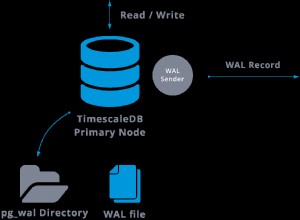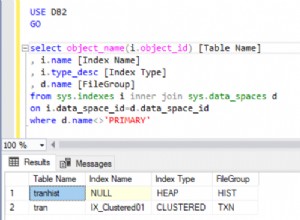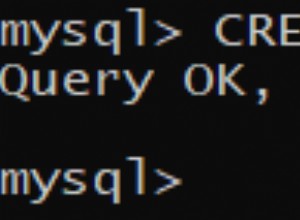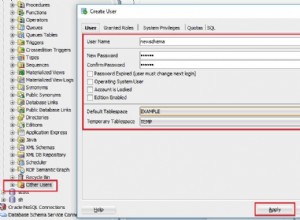Lorsque j'ai commencé à répondre à cette question, je pensais que ce serait rapide et facile car j'avais fait quelque chose de très similaire une fois dans SQL Server, mais prouver le concept de traduction a fait son apparition dans cette solution complète.
Une mise en garde qui n'était pas claire dans votre question est de savoir si vous avez une condition pour déclarer l'identifiant principal par rapport à l'identifiant d'alias. Par exemple, cette solution permettra à 1 d'avoir un alias de 4 ainsi qu'à 4 d'avoir un alias de 1, ce qui est cohérent avec les données fournies dans votre exemple de question simplifié.
Pour configurer les données de cet exemple, j'ai utilisé cette structure :
CREATE TABLE notnormal_customers (
id INT NOT NULL PRIMARY KEY,
aliases VARCHAR(10)
);
INSERT INTO notnormal_customers (id,aliases)
VALUES
(1,'|4|58|76'),
(2,''),
(3,''),
(4,'|1|58|76'),
(58,'|1|4|76'),
(76,'|1|4|58');
Tout d'abord, afin de représenter la relation un-à-plusieurs pour un client à plusieurs alias, j'ai créé ce tableau :
CREATE TABLE customer_aliases (
primary_id INT NOT NULL,
alias_id INT NOT NULL,
FOREIGN KEY (primary_id) REFERENCES notnormal_customers(id),
FOREIGN KEY (alias_id) REFERENCES notnormal_customers(id),
/* clustered primary key prevents duplicates */
PRIMARY KEY (primary_id,alias_id)
)
Plus important encore, nous utiliserons un personnalisé SPLIT_STR fonction
:
CREATE FUNCTION SPLIT_STR(
x VARCHAR(255),
delim VARCHAR(12),
pos INT
)
RETURNS VARCHAR(255)
RETURN REPLACE(SUBSTRING(SUBSTRING_INDEX(x, delim, pos),
LENGTH(SUBSTRING_INDEX(x, delim, pos -1)) + 1),
delim, '');
Ensuite, nous allons créer une procédure stockée pour faire tout le travail. Le code est annoté avec des commentaires sur les références des sources.
DELIMITER $$
CREATE PROCEDURE normalize_customers()
BEGIN
DECLARE cust_id INT DEFAULT 0;
DECLARE al_id INT UNSIGNED DEFAULT 0;
DECLARE alias_str VARCHAR(10) DEFAULT '';
/* set the value of the string delimiter */
DECLARE string_delim CHAR(1) DEFAULT '|';
DECLARE count_aliases INT DEFAULT 0;
DECLARE i INT DEFAULT 1;
/*
use cursor to iterate through all customer records
http://burnignorance.com/mysql-tips/how-to-loop-through-a-result-set-in-mysql-strored-procedure/
*/
DECLARE done INT DEFAULT 0;
DECLARE cur CURSOR FOR
SELECT `id`, `aliases`
FROM `notnormal_customers`;
DECLARE CONTINUE HANDLER FOR NOT FOUND SET done = 1;
OPEN cur;
read_loop: LOOP
/*
Fetch one record from CURSOR and set to customer id and alias string.
If not found then `done` will be set to 1 by continue handler.
*/
FETCH cur INTO cust_id, alias_str;
IF done THEN
/* If done set to 1 then exit the loop, else continue. */
LEAVE read_loop;
END IF;
/* skip to next record if no aliases */
IF alias_str = '' THEN
ITERATE read_loop;
END IF;
/*
get number of aliases
https://pisceansheart.wordpress.com/2008/04/15/count-occurrence-of-character-in-a-string-using-mysql/
*/
SET count_aliases = LENGTH(alias_str) - LENGTH(REPLACE(alias_str, string_delim, ''));
/* strip off the first pipe to make it compatible with our SPLIT_STR function */
SET alias_str = SUBSTR(alias_str, 2);
/*
iterate and get each alias from custom split string function
https://stackoverflow.com/questions/18304857/split-delimited-string-value-into-rows
*/
WHILE i <= count_aliases DO
/* get the next alias id */
SET al_id = CAST(SPLIT_STR(alias_str, string_delim, i) AS UNSIGNED);
/* REPLACE existing values instead of insert to prevent errors on primary key */
REPLACE INTO customer_aliases (primary_id,alias_id) VALUES (cust_id,al_id);
SET i = i+1;
END WHILE;
SET i = 1;
END LOOP;
CLOSE cur;
END$$
DELIMITER ;
Enfin, vous pouvez simplement l'exécuter en appelant :
CALL normalize_customers();
Ensuite, vous pouvez vérifier les données dans la console :
mysql> select * from customer_aliases;
+------------+----------+
| primary_id | alias_id |
+------------+----------+
| 4 | 1 |
| 58 | 1 |
| 76 | 1 |
| 1 | 4 |
| 58 | 4 |
| 76 | 4 |
| 1 | 58 |
| 4 | 58 |
| 76 | 58 |
| 1 | 76 |
| 4 | 76 |
| 58 | 76 |
+------------+----------+
12 rows in set (0.00 sec)




